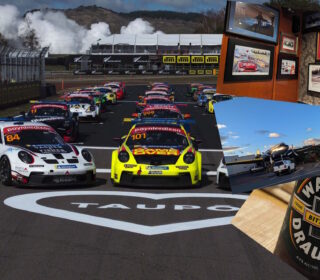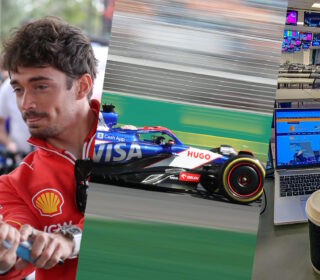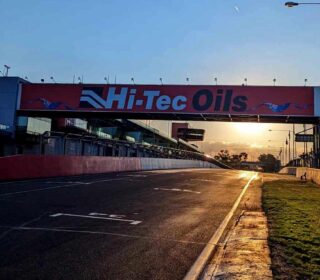The real story of Jimmie Johnson’s rookie Indy season
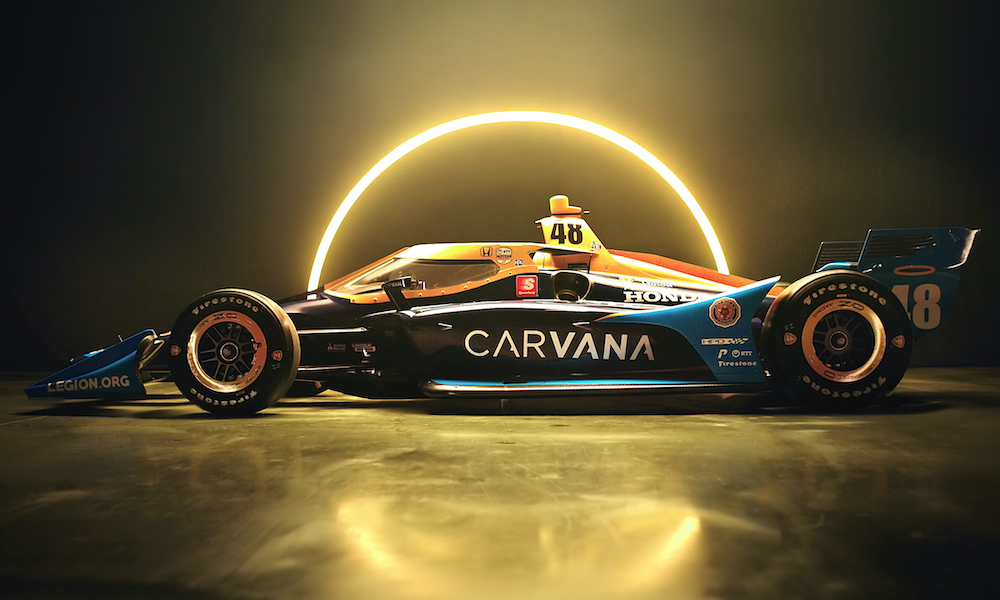
SEVEN TIMES a NASCAR Champion, Jimmie Johnson could easily have retired from the sport at the end of the 2020 season.
With millions in the bank, a young family around him and any number of business or racing ventures to tackle outside of the cockpit, his reputation as one of the very best drivers’ in the history of top-level stock car racing in America was assured.
And yet, no. Instead, at the age of 45 the Californian has elected to go IndyCar racing; forgetting everything he has learned in NASCAR to tackle an entirely new artform in an entirely new paddock that is about as competitive as it has ever been.
It’s a story that is as rare as it is courageous given just how tough it is to be competitive in IndyCar racing as an experienced driver – let alone as someone with very little experience at doing anything other than turning left.. or steering anything with meaningful Downforce.
NASCAR, even with their current road racing push, and IndyCar are about as far apart as you can find when it comes to different disciplines in the same sporting sphere; it’s like asking to compare the sprinting capabilities of an Olympic Shot Putter to Cathy Freeman.
And yet, here he is. He went and found a sponsor, he did a deal with Chip Ganassi Racing to ensure he was in a top team, went testing and fronted up every bit the rookie driver in a field mixed with hotshot young guns and veteran superstars of the sport who rank among the all-time Indy greats.
Of course, some have already been critical – despite Johnson having completed just five races at the time we his publish on this feature.
Forum boards and Facebook comments are quick to diminish Johnson’s season and his IndyCar transition and if you look at the results, they certainly don’t look great be it in comparison to his fellow rookie class or the field overall.
And yet, like everything in Motorsport, there is much more to what we are witnessing than just raw finishing numbers. Some fans and media forget that there’s much more nuance to our game than just a number on a piece of paper, or a well-televised spin.
Though Johnson’s IndyCar career is only five races old (he’s not racing the Oval races on the calendar, and there have been three so far), the half-way point of the 2021 IndyCar series gave us pause to look closer at the real story of Jimmie Johnson’s debut season – with the benefit of some context and without the reactionary tosh you’ll find in a comments section.
And with context, comes history. Read on..
THE PATHWAY
JOHNSON’S pathway to IndyCar racing is perhaps one of the most unique the series has seen, at least in the modern era of high downforce, high speed cars that are closer to Formula One machinery than the short-track roots of the Indianapolis 500.
The Californian started racing motorbikes as a four-year-old, switching to cars and the rigorous demands of off-road racing as a teenager when he had completed schooling.
His off-road career was successful, netting several championships along the way – but it would also be the last time that Johnson would turn left and right with regularity for more than two decades.
In 1997 he linked with Herzog Motorsports to enter the American Speed Association (ASA) series in stock cars, winning a rookie title in 1998.
The rest is reasonably well documented history. After moving into NASCAR’s Busch – now Xfinity – Series Johnson was talent-spotted by Jeff Gordon, who convinced team owner Rick Hendrick to sign the still-young driver for an expanded Hendrick Motorsports Cup program, one co-owned by Gordon, sporting the now-famous #48.
It would be the step towards history as Johnson started carving out a career as one of the most successful drivers’ in the long history of top-level US Stock Car racing.
NASCAR
THERE is very little point in us recapping Johnson’s NASCAR career in great detail because if you read this site, there’s a good chance you’ll know it already.
His first career win came just 10 races into his debut full-time season in 2002, en route to fifth in the championship in his rookie season.
He was twice runner-up in 2003 and ’04, and fifth again in 2005 before things clicked the following year.
After winning his first Daytona 500 in early 2006, Johnson went on a rampage and would dominate the sport for the next five straight seasons: winning every title through 2010 to end the decade a five-time Cup champion and in the league of the greats.
He wasn’t done yet though; further titles coming in 2013 and then 2016 to leave him a seven-time champion, equal only to legends Dale Earnhardt and Richard Petty on the all-time list.
7 PER CENT ROAD RACING
BEFORE joining IndyCar at the start of the 2021 season, Jimmie Johnson’s racing career wasn’t just dominated by Oval track racing – it was almost exclusively centred around it with 93% of his entire pre-IndyCar career was spent turning left.
Of his 686 NASCAR Cup Series starts, just 40 of them were on tracks where he had to turn left and right. Still, he always acquitted himself well at the discipline.
From those 40 races, he won once (at Sonoma, California, in 2010) and scored 18 Top-10 finishes.
“Percentage-wise, he’s getting to those last few tenths. He’s trying to recalibrate 20 years of driving stock cars. He’s not coming from zero, he’s coming from less than zero because of his stock car habits.”
Dario Franchitti, who knows a thing or two about driving..
From his entire career pre-2021, Johnson had started just 55 notable road course races in total, with the 40 Cup starts at Watkins Glen, Sonoma, Indianapolis and the Charlotte Roval, complimented by a further four in the second-tier Xfinity Series (for a best of 2nd) and 11 starts in either Grand-Am or IMSA competition driving Sports Cars.
Eight of those were in the Rolex24 Hours of Daytona; a race where this year he finished second sharing a Cadillac with Kamui Kobayashi, Simon Pagenaud and Mike Rockenfeller.
THE TOUGH TASK AHEAD
JOHNSON’S debut IndyCar season came amidst a small crop of rookie drivers, yet probably the best credentialed first-year drivers in the long history of the sport.
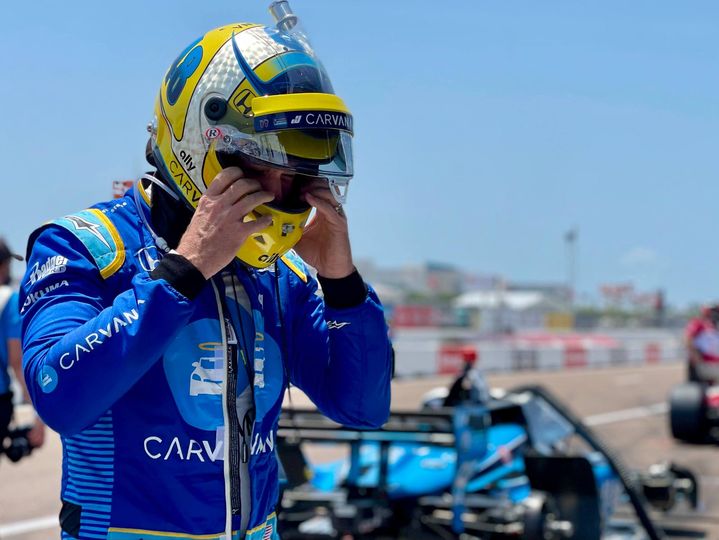
Firstly there was Formula One veteran Romain Grosjean, whose 179 Formula 1 starts had delivered 10 podium finishes and several ‘what if’ moments that could have led to a race victory when he was in the right machinery
And then there was Scott McLaughlin; inexperienced in open wheel competition yet a triple champion in Supercars and with road-racing roots going back to the moment he first jumped in a Go-Kart.
That, along with one of the deepest and most talented grids in post-Merger IndyCar history, would be what a man with just 55 Road Races worth of experience in his entire life would be facing.
“He’s closed the gap to where he needs to be,” four-time IndyCar champion Dario Franchitti told Autoweek after Johnson’s final laps of testing prior to the start of the season proper.
“Percentage-wise, he’s getting to those last few tenths. He’s trying to recalibrate 20 years of driving stock cars. He’s not coming from zero, he’s coming from less than zero because of his stock car habits.
“Talent-wise, you’ve seen what he’s done. It’s ridiculous. He’s got so much talent. His work ethic is incredible.”
What’s more, a seven-time Cup champion is probably the highest profile driver to come into IndyCar racing since Formula One World Champion Nigel Mansell crossed the Atlantic to have a crack at the ‘States in 1993.
At the time of his NASCAR retirement, Johnson was still one of the biggest names in the sport and while the resulting media interest has been a boon for the open wheel series, it also makes for a rookie season more scrutinised in the American motorsport media and fandom than most before it.
So naturally, with the eyes of America watching, any bumps in the road are going to be grasped on by media and fans alike awfully quickly.
FORGET THE RESULTS: CRUNCH THE NUMBERS
WITH the context now clear – Johnson is as proper a road racing ‘rookie’ as there has ever been – it’s time to have a look at his season dispassionately and without the incredible weight of expectation that being a seven-time NASCAR champion brings.
While results of 19th, 22nd, 24th, 24th and 21st respectively don’t look impressive in the slightest, they also fail to give the real story of the progress he’s made.
Plus, for additional context, it’s worth considering this: IndyCar star James Hinchcliffe has 6 wins and 17 podium finishes to his credit in the series; yet his season has seen a best finish of 14th position, with no other finishes higher than 17th. And he’s a guy who has contended for championships and won the pole at Indy.
Suffice to say, 2021-spec IndyCar racing is bloody tough.
Crunching the raw data of the 48’s season so far showcases real improvement and performance gains throughout the five events he has contested to date.
Round 1 of the championship at Barber Motorsport Park in Alabama saw Johnson’s first experience with a high-downforce natural terrain road course – a track where IndyCars are at their best but also at their most physical.
In qualifying, his 67.70s best saw him 2.2 seconds behind Pato O’Ward’s fastest lap of the session (65.50s). By the end of the race, Johnson had found nearly six-tenths worth of improvement, with his best race lap 1.6s slower than the race’s fastest.
From his overall career pre-2021, Johnson had started just 55 Road Course races in total, with the 40 Cup Road Course races complimented by a further four in the second-tier Xfinity Series (for a best of 2nd) and 11 starts in either Grand-Am or IMSA competition driving Sports Cars.
On the shorter lap at St. Petersburg the margin had closed further: Johnson was 1.6 seconds behind Colton Herta’s qualifying best, but closed that margin to 1.2 seconds in the race when his best lap (62.71s) was solid to Alex Palou’s best of 61.48s.
The GMR Grand Prix on the Indianapolis Motor Speedway Road Course was something of an outlier; though the margins remained consistent with St. Pete despite a 10-second longer lap time difference between the two venues.
In Qualifying, Johnson ended up 1.6 seconds behind pole man Romain Grosjean, with a similar margin of just over 1.7s behind Reenus Veekay’s best lap of the race.
However, it was perhaps the bumpy streets of Detroit where Johnson’s massive learning curve was both exposed and showcased positively at the same time.
On one of the toughest street circuits on the calendar, filled with bumps, surface changes and rapidly changing grip levels depending on the weather, Johnson battled in qualifying to end up 3.5 seconds slower than polesitter Pato O’Ward’s best lap.
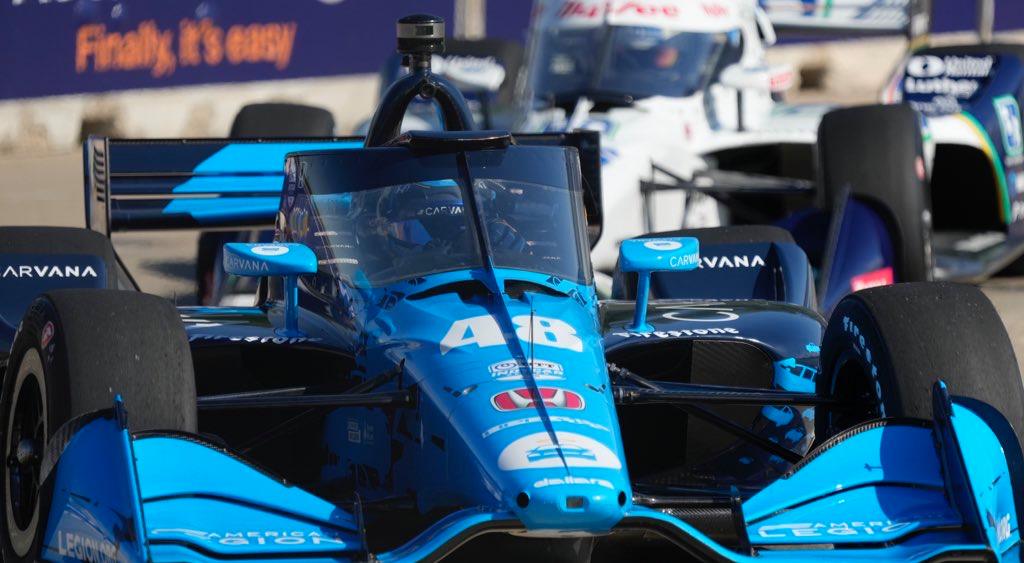
The Detroit event was doubly brutal: Just one practice session was held before the field launched in qualifying and then the first race. What’s more, temperatures were scorching on the Saturday.
In the first race Johnson shaved half a second from his qualifying time, but relative to the fastest lap of the race his improvement was a full 1.5 seconds; his best of 1m18.56s comparing well to Josef Newgarden’s 1m16.64s quickest time.
Sunday was even better, despite the late-race spin that saw him drop a lap; his fastest race lap of 1m17.6158s was a full 2.2 seconds better than his qualifying time and just 1.2s slower than Colton Herta’s fastest lap of the race.
On average, Johnson has improved nearly a full second between qualifying and the race at each road course event this year.
Here’s a handy table that explains more with numbers and facts.
| Barber Motorsport Park | ||||||
| Session | Fastest Lap | Driver | Johnson Time | Gap to best | % off | Gain |
| Qualifying | 65.5019 | Pato O’Ward | 67.7092 | 2.2073 | 3% | |
| Race | 66.8182 | Pato O’Ward | 68.4411 | 1.6229 | 2% | 0.5844 |
| Streets of St Petersburg | Fastest Lap | Driver | Johnson Time | Gap to best | % off | Gain |
| Qualifying | 60.2207 | Colon Herta | 61.8364 | 1.6157 | 3% | |
| Race | 61.4568 | Alex Palou | 62.7196 | 1.2628 | 2% | 0.3529 |
| Grand Prix of Indianapolis | Fastest Lap | Driver | Johnson Time | Gap to best | % off | Gain |
| Qualifying | 69.4396 | Romain Grosjean | 71.0455 | 1.6059 | 2% | |
| Race | 70.8767 | Reenus VeeKay | 72.5976 | 1.7209 | 2% | -0.115 |
| Detroit Grand Prix | Fastest Lap | Driver | Johnson Time | Gap to best | % off | Gain |
| Qualifying | 75.5766 | Pato O’Ward | 79.0944 | 3.5178 | 5% | |
| Race 1 | 76.6433 | Josef Newgarden | 78.5678 | 1.9245 | 3% | 1.5933 |
| Race 2 | 76.3434 | Colon Herta | 77.6158 | 1.2724 | 2% | 2.2454 |
SOURCE: IndyCar.com
SO, WHAT DOES IT MEAN?
IT IS very easy to be critical of Jimmie Johnson’s IndyCar debut given everything he has going for him – team, sponsor, car, coaches, engineers, teammates and the like all being first class, the best you can get.
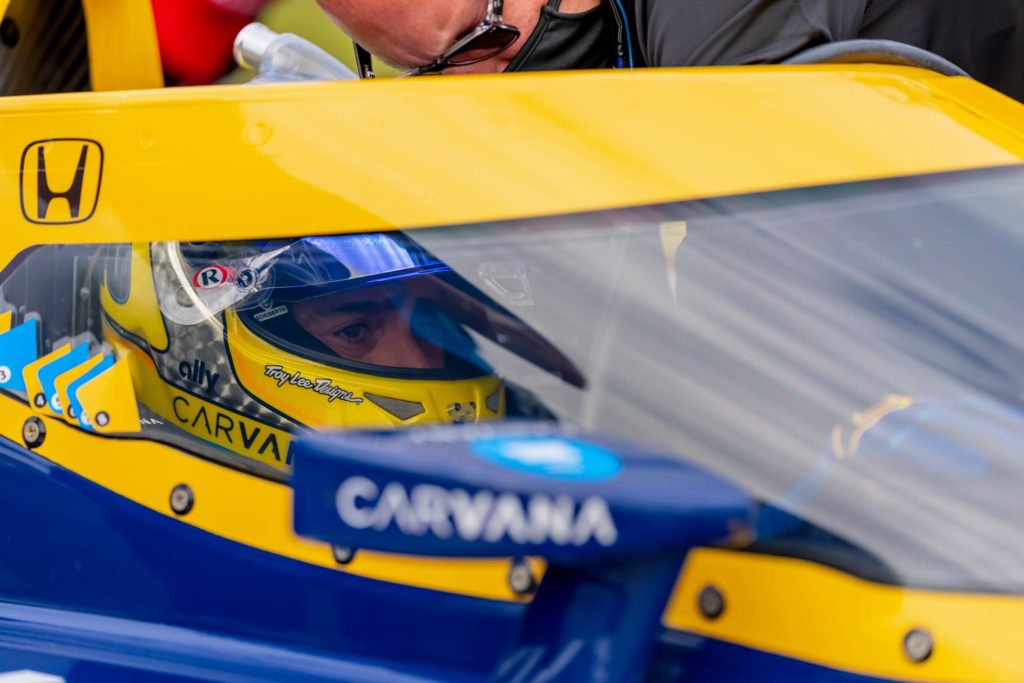
Certainly, it’s as good a ‘rookie’ program you’re ever going to see in motorsport.. but then again, Scott McLaughlin landed directly into a Team Penske drive so perhaps it’s not quite all that after all.
Still, when you look beyond the simplistic race and qualifying results and take into account the sheer lack of experience that the 45-year-old Californian has on anything other than high-banked NASCAR ovals, the weight of his accomplishments becomes clearer.
Sure he has been roundly beaten by Grosjean and McLaughlin, but then again the Frenchman has literally a decade of experience racing the fastest racing cars in the world behind him. The Kiwi has the same experience in one of the most competitive Touring Car formulas around.. not to mention two extra decades of youth on his side as well.
Jimme Johnson is a middle-aged NASCAR driver with less than 60 races under his belt where you have to turn left and right on his resume’ in his entire life, racing in an ultra-competitive championship where the difference between the best car on the grid and the worst is at most six or seven-tenths of a second.
Given just how fundamentally different NASCAR and IndyCar racing really are, when you put it all into perspective what he’s achieved in just five races doesn’t look too bad at all.
Only history will be able to judge if Jimmie Johnson’s IndyCar career can be classified a success or not and if we’re totally honest, its doubtful there are many out there who expect him to end up being anything other than mid-pack at best.
And yet, with just five races under his belt he’s found chunks of time and in racing conditions can now get within, broadly, a second of the fastest guys in the series.
Speaking to Autoweek, Dario Franchitti summed up the task awaiting Johnson prior to the opening round.
“It’s going to be difficult at the beginning, it’s going to be hard, let’s not beat about the bush. He’s never been on a street course before. When he gets to St. Pete that’s’s going to be hard. He continuously wants to test himself and to push himself, and we being Chip Ganassi Racing are giving him everything we possibly can to succeed.
“It’s a really cool thing to watch–his development, watch the way his mind works. He’s a hard-working smart guy.”
Finding those last few tenths is always the hardest part, but with seven races left in his schedule that rate of improvement should lift him off the back row of the grid by season’s end. And next year, with a full season under his belt and knowledge of circuits lodged in the brain? Who knows what will happen.
Regardless, we are watching a driver courageous enough to throw away years of experience and skill to start from scratch in the fifth decade of his life.
He could have easily hung up the helmet and retired comfortably with his family, but chose instead to challenge himself with something very new in a very public forum.
Results or not, that alone deserves all the respect possible.
PHOTOS: Courtesy Carvana Racing



